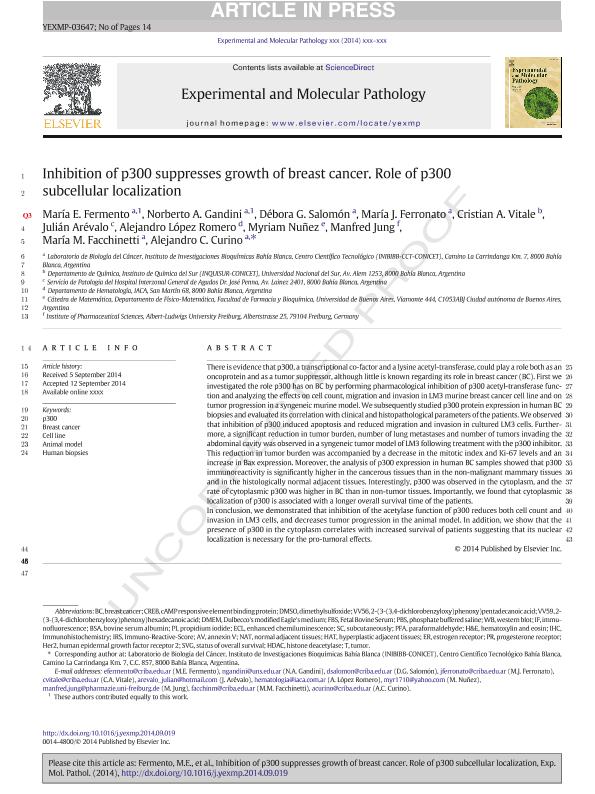Mostrar el registro sencillo del ítem
dc.contributor.author
Fermento, María Eugenia

dc.contributor.author
Gandini, Norberto Ariel

dc.contributor.author
Salomón, Débora Gisele

dc.contributor.author
Ferronato, María Julia
dc.contributor.author
Vitale, Cristian Alejandro
dc.contributor.author
Arevalo, Julian
dc.contributor.author
Lopez Romero, Alejandro
dc.contributor.author
Nuñez, Myriam Carmen
dc.contributor.author
Jung, Manfred
dc.contributor.author
Facchinetti, Maria Marta

dc.contributor.author
Curino, Alejandro Carlos

dc.date.available
2016-02-29T18:18:40Z
dc.date.issued
2014-09
dc.identifier.citation
Fermento, María Eugenia; Gandini, Norberto Ariel; Salomón, Débora Gisele; Ferronato, María Julia; Vitale, Cristian Alejandro; et al.; Inhibition of p300 suppresses growth of breast cancer. Role of p300 subcellular localization; Academic Press Inc Elsevier Science; Experimental And Molecular Pathology.; 97; 9-2014; 411-424
dc.identifier.issn
0014-4800
dc.identifier.uri
http://hdl.handle.net/11336/4520
dc.description.abstract
There is evidence that p300, a transcriptional co-factor and a lysine acetyl-transferase, could play a role both as an oncoprotein and as a tumor suppressor, although little is known regarding its role in breast cancer (BC). First we investigated the role p300 has on BC by performing pharmacological inhibition of p300 acetyl-transferase function and analyzing the effects on cell count, migration and invasion in LM3 murine breast cancer cell line and on tumor progression in a syngeneic murine model. We subsequently studied p300 protein expression in human BC biopsies and evaluated its correlation with clinical and histopathological parameters of the patients. We observed that inhibition of p300 induced apoptosis and reduced migration and invasion in cultured LM3 cells. Furthermore, a significant reduction in tumor burden, number of lung metastases and number of tumors invading the abdominal cavity was observed in a syngeneic tumor model of LM3 following treatment with the p300 inhibitor. This reduction in tumor burden was accompanied by a decrease in the mitotic index and Ki-67 levels and an increase in Bax expression. Moreover, the analysis of p300 expression in human BC samples showed that p300 immunoreactivity is significantly higher in the cancerous tissues than in the non-malignant mammary tissues and in the histologically normal adjacent tissues. Interestingly, p300 was observed in the cytoplasm, and the rate of cytoplasmic p300 was higher in BC than in non-tumor tissues. Importantly, we found that cytoplasmic localization of p300 is associated with a longer overall survival time of the patients. In conclusion, we demonstrated that inhibition of the acetylase function of p300 reduces both cell count and invasion in LM3 cells, and decreases tumor progression in the animal model. In addition, we show that the presence of p300 in the cytoplasm correlates with increased survival of patients suggesting that its nuclear localization is necessary for the pro-tumoral effects.
dc.format
application/pdf
dc.language.iso
eng
dc.publisher
Academic Press Inc Elsevier Science

dc.rights
info:eu-repo/semantics/openAccess
dc.rights.uri
https://creativecommons.org/licenses/by-nc-nd/2.5/ar/
dc.subject
Breast Cancer
dc.subject
P300
dc.subject
Cell Line
dc.subject
Animal Model
dc.subject
Human Biopsies
dc.subject.classification
Patología

dc.subject.classification
Medicina Básica

dc.subject.classification
CIENCIAS MÉDICAS Y DE LA SALUD

dc.title
Inhibition of p300 suppresses growth of breast cancer. Role of p300 subcellular localization
dc.type
info:eu-repo/semantics/article
dc.type
info:ar-repo/semantics/artículo
dc.type
info:eu-repo/semantics/publishedVersion
dc.date.updated
2016-03-30 10:35:44.97925-03
dc.journal.volume
97
dc.journal.pagination
411-424
dc.journal.pais
Estados Unidos

dc.journal.ciudad
Amsterdam
dc.description.fil
Fil: Fermento, María Eugenia. Consejo Nacional de Investigaciones Científicas y Técnicas. Centro Científico Tecnológico CONICET Bahía Blanca. Instituto de Investigaciones Bioquímicas Bahía Blanca (i); Argentina
dc.description.fil
Fil: Gandini, Norberto Ariel. Consejo Nacional de Investigaciones Científicas y Técnicas. Centro Científico Tecnológico CONICET Bahía Blanca. Instituto de Investigaciones Bioquímicas Bahía Blanca (i); Argentina
dc.description.fil
Fil: Salomón, Débora Gisele. Consejo Nacional de Investigaciones Científicas y Técnicas. Centro Científico Tecnológico CONICET Bahía Blanca. Instituto de Investigaciones Bioquímicas Bahía Blanca (i); Argentina
dc.description.fil
Fil: Ferronato, María Julia. Consejo Nacional de Investigaciones Científicas y Técnicas. Centro Científico Tecnológico CONICET Bahía Blanca. Instituto de Investigaciones Bioquímicas Bahía Blanca (i); Argentina
dc.description.fil
Fil: Vitale, Cristian Alejandro. Universidad Nacional del Sur. Departamento de Química; Argentina
dc.description.fil
Fil: Arevalo, Julian. Hospital Int. Gral. de Agudos Dr. Jose Penna. Servicio de Patologia; Argentina
dc.description.fil
Fil: Lopez Romero, Alejandro. Laboratorios IACA. Departamento de Hematología; Argentina
dc.description.fil
Fil: Nuñez, Myriam Carmen. Universidad de Buenos Aires. Facultad de Farmacia y Bioquímica. Departamento de Físico Matemática; Argentina
dc.description.fil
Fil: Jung, Manfred. Albert-Ludwigs University Freiburg. Institute of Pharmaceutical Sciences; Alemania
dc.description.fil
Fil: Facchinetti, Maria Marta. Consejo Nacional de Investigaciones Científicas y Técnicas. Centro Científico Tecnológico CONICET Bahía Blanca. Instituto de Investigaciones Bioquímicas Bahía Blanca (i); Argentina
dc.description.fil
Fil: Curino, Alejandro Carlos. Consejo Nacional de Investigaciones Científicas y Técnicas. Centro Científico Tecnológico CONICET Bahía Blanca. Instituto de Investigaciones Bioquímicas Bahía Blanca (i); Argentina
dc.journal.title
Experimental And Molecular Pathology.

dc.relation.alternativeid
info:eu-repo/semantics/altIdentifier/doi/10.1016/j.yexmp.2014.09.019
dc.relation.alternativeid
info:eu-repo/semantics/altIdentifier/url/http://www.ncbi.nlm.nih.gov/pubmed/25240203
dc.relation.alternativeid
info:eu-repo/semantics/altIdentifier/doi/http://dx.doi.org/10.1016/j.yexmp.2014.09.019
Archivos asociados
